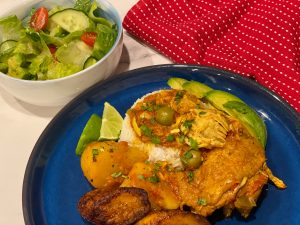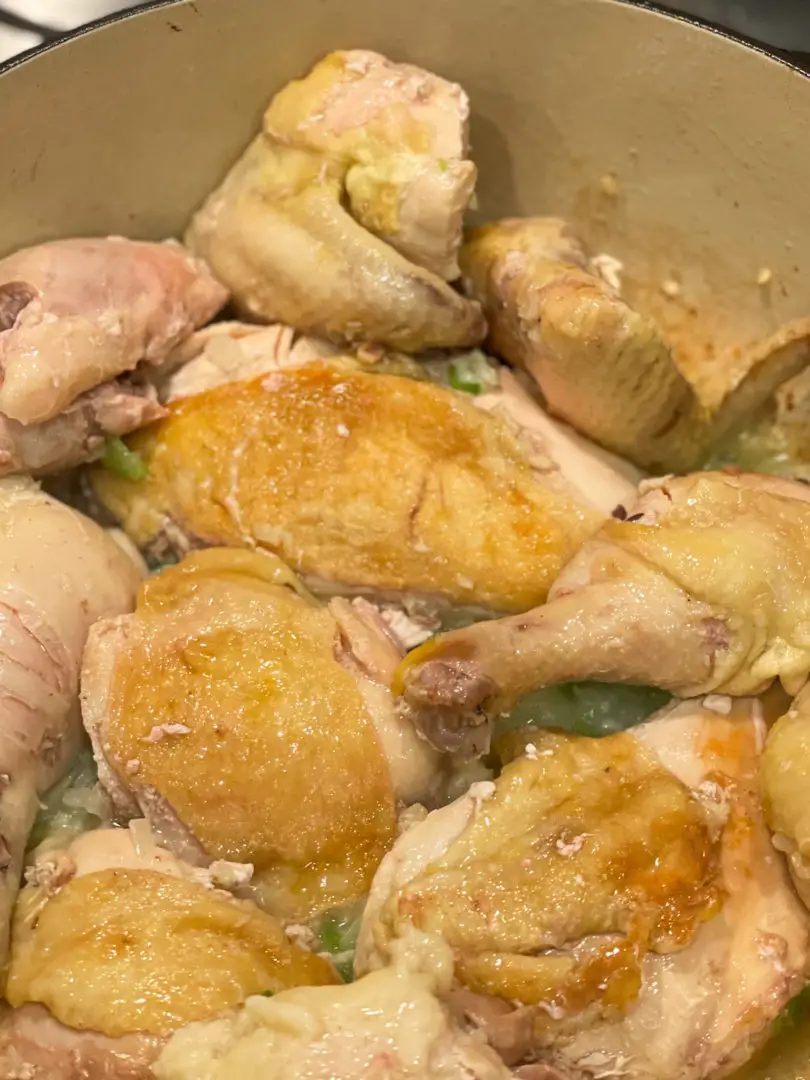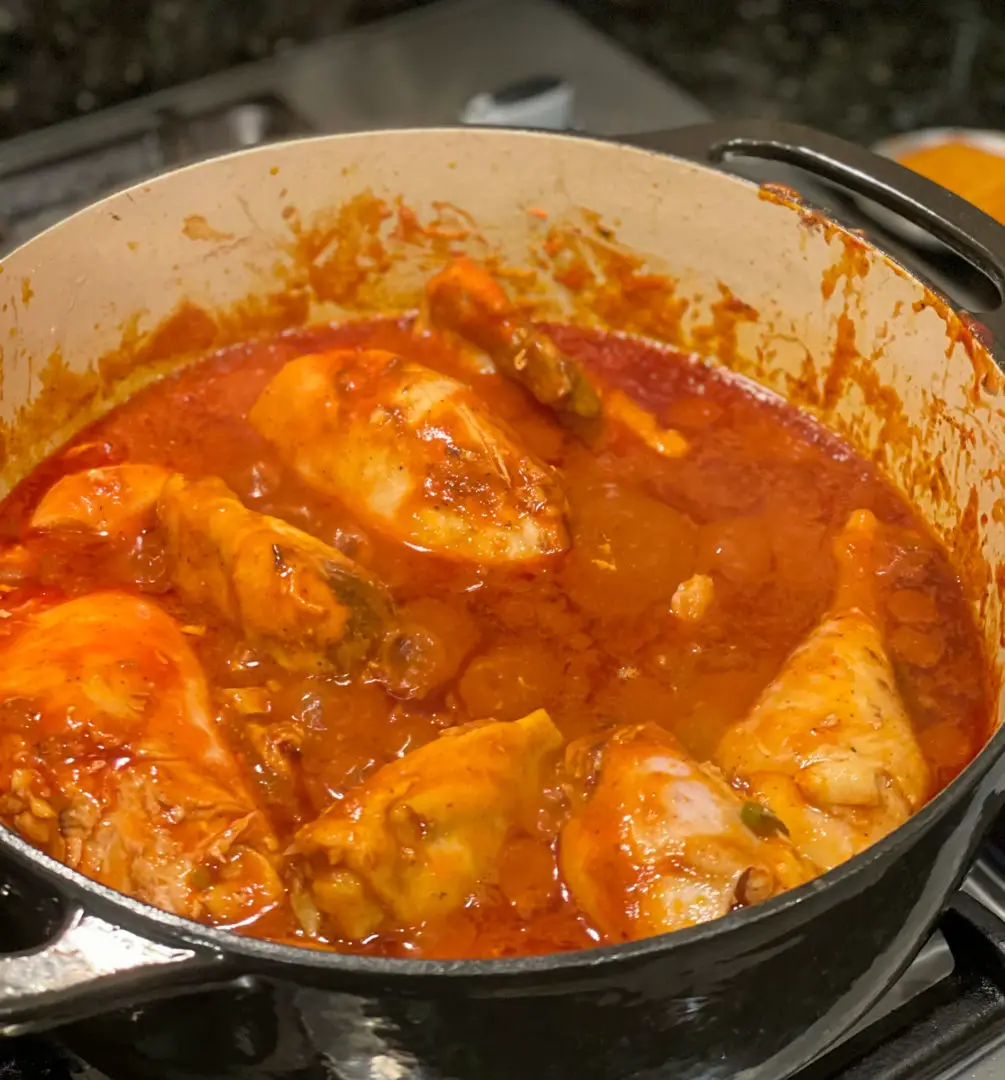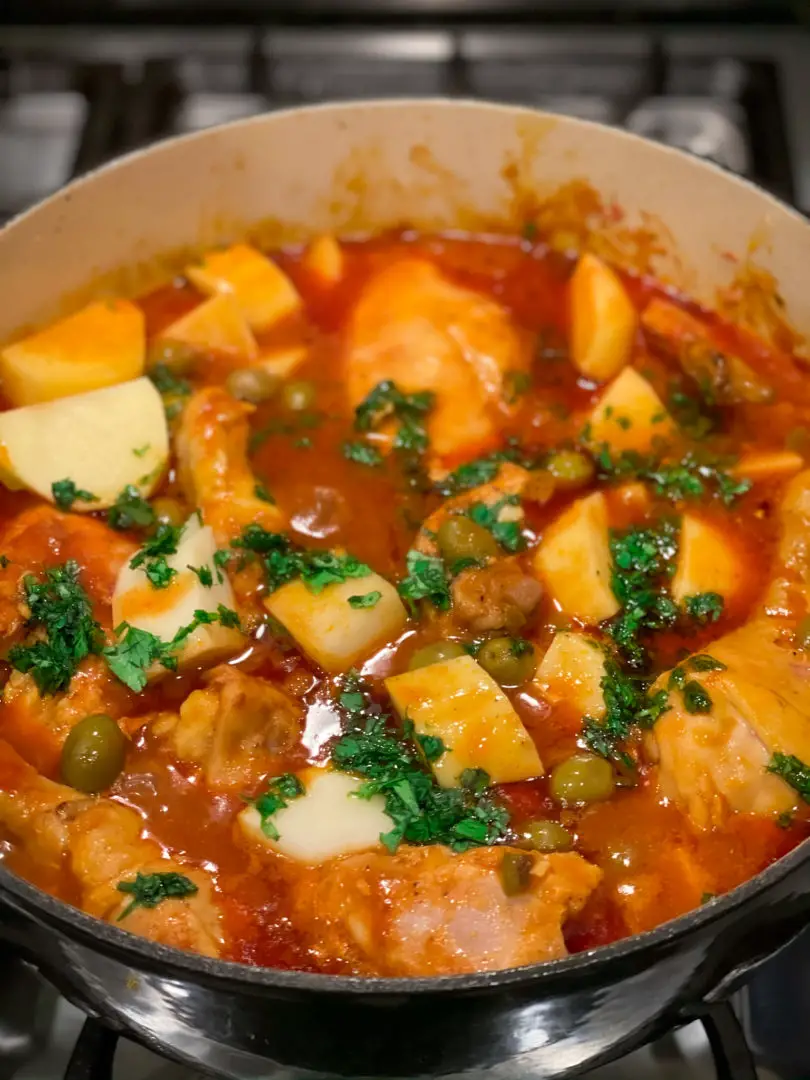How To Make Fricase de Pollo (Chicken Fricassee)
Step into the vibrant world of Cuban cuisine with a timeless favorite—Chicken Fricassee. Embark on a culinary journey infused with rich flavors and cultural significance as we uncover the art of crafting this traditional dish. From tender chicken simmered in a savory tomato-based (sofrito) sauce to the aromatic blend of herbs and spices, every element of Cuban Chicken Fricassee tells a story of heritage and passion for food.
Chicken Fricassee is the first Cuban dish that I mastered. Do you want to know why? This dish quickly became a go-to with the arrival of kids. The aromatic symphony of chicken and potatoes simmering in a Dutch oven fills the house with enticing scents, setting the stage for a delightful family dinner.
What is Cuban Chicken Fricassee?
Cuban Chicken Fricassee, known as “Fricasé de Pollo” in Spanish, holds a special place in the hearts of Cubans and is deeply rooted in the country’s culinary heritage. This iconic dish is a beautiful fusion of Spanish, African, and Caribbean influences, reflecting the diverse cultural tapestry of Cuba. Its origins can be traced back to the traditional French fricassee, which was adapted and transformed over generations as it made its way to the shores of Cuba.
So, as the wise Julia Child said, a fricassee is half way between a saute and a stew. A saute has no liquid and a stew starts with a liquid. A fricassee sautes the meat first then some liquid is added and simmered to finish. Cuban chicken fricassee is just that. We are going to saute cut up pieces of chicken and then make a red sofrito sauce that will simmer with potatoes to be served over a bed of rice.
Now, depending on the time of year it is, I like to change the way I make the sauce. During the winter I will use tomato sauce for a deep richer flavor. Tomato sauce gives the fricase de pollo a thicker comfort food feel that warms you from the inside out. However, during the spring and summer I like to use fresh cherry tomatoes. The sauce stays light and fresh as pictured below.

Chicken Fricassee is one of those dishes that gets better and better the longer the flavors mix together. I like to make extra so the next day there is plenty for an amazing second meal for lunch or dinner. Also depending on your personal likes you can use a whole cut up chicken like I’m going to show you here, or you can use boneless skinless breast or thighs, or a combination of all three. The versatility is awesome!
Key Ingredients for Authentic Cuban Chicken Fricassee
The authenticity of Cuban Chicken Fricassee lies in the careful selection of ingredients that contribute to its distinctive flavors and aromas. At the heart of this flavorful dish is succulent chicken, traditionally cut into pieces with the bone-in for added depth of flavor. The combination of onion, garlic, bell peppers, and tomatoes forms the flavorful base of the sauce (sofrito), infusing the dish with a rich and savory essence.
To elevate the taste profile, Cuban Chicken Fricassee incorporates a harmonious blend of herbs and spices, including cumin, bay leaves, and a hint of bijol. These aromatic elements come together to create a symphony of flavors that tantalize the palate and evoke the essence of Cuban culinary tradition.
In addition to the essential ingredients, green olives add a delightful briny complexity to the dish, providing bursts of tanginess that balance the savory notes of the sauce. The marriage of these key components forms the foundation of authentic Cuban Chicken Fricassee, ensuring a truly soul-satisfying dining experience.
Tips for Perfecting the Flavors and Texture
Creating an exceptional Cuban Chicken Fricassee hinges on a few key tips that can elevate the dish from good to extraordinary.
When searing the chicken, aim for a golden-brown caramelization, as this step imparts a depth of flavor that forms the foundation of the dish. Additionally, ensure that the sauce simmers gently, allowing the ingredients to meld and the flavors to intensify without compromising the tender texture of the chicken.
For an extra layer of authenticity, consider using a traditional Cuban cooking vessel, such as a “cazuela” or a heavy-bottomed pot, to prepare the dish. The slow, even heat distribution of these vessels contributes to the development of nuanced flavors and a velvety texture that defines an exceptional Cuban Chicken Fricassee.
Serving Suggestions and Accompaniments
The presentation and serving of Cuban Chicken Fricassee are as vital as the cooking process itself, as they contribute to the overall sensory experience of the dish. Traditionally, this hearty dish is served atop a bed of fluffy white rice, allowing the savory sauce to mingle with the grains and create a harmonious blend of flavors.
To complement the robust nature of the dish, consider garnishing it with fresh cilantro or parsley, adding a vibrant pop of color and a hint of herbal freshness. A side of sweet, maduros (fried plantains) or crispy yuca fries serves as the perfect accompaniment, offering contrasting textures and complementary flavors that elevate the dining experience.
For a refreshing contrast, a simple avocado salad with a drizzle of olive oil and red wine vinegar can provide a crisp, cool counterpoint to the hearty warmth of the Chicken Fricassee. The art of plating and pairing is an extension of the culinary journey, inviting guests to savor the diverse elements of Cuban cuisine in a harmonious and visually appealing manner.
Health Benefits of Cuban Chicken Fricassee
In addition to its irresistible flavors, Cuban Chicken Fricassee offers a range of health benefits, making it an excellent choice for those seeking nourishing, wholesome meals. The dish is abundant in lean protein from the chicken, providing essential nutrients for muscle health and overall well-being.
The inclusion of vibrant bell peppers and tomatoes infuses the dish with an array of vitamins, antioxidants, and dietary fiber, promoting a healthy immune system and digestive wellness. The aromatic herbs and spices not only enhance the flavors but also contribute to the dish’s health-promoting properties, with ingredients like garlic and cumin known for their potential immune-boosting and anti-inflammatory effects.
When prepared with care and mindful ingredient selection, Cuban Chicken Fricassee embodies the essence of a balanced, health-conscious meal that nourishes the body while delighting the senses—a testament to the holistic approach to food that is deeply ingrained in Cuban culinary traditions.
Conclusion: Bringing the Flavors of Cuba to Your Table
As we conclude our exploration of the art of making Cuban Chicken Fricassee, we have peeled back the layers of history, flavor, and tradition to unveil the essence of this beloved dish. From its humble origins to its evolution into a symbol of Cuban conviviality, Chicken Fricassee embodies the spirit of sharing, savoring, and celebrating the joys of life around the dining table.
Let the spirit of Cuban Chicken Fricassee infuse your kitchen with the vibrant energy of Havana, the soulfulness of Santiago de Cuba, and the warmth of a family gathering under the Caribbean sun. With each serving, you honor the traditions, the flavors, and the enduring legacy of Cuban cuisine, making every meal a celebration of the rich tapestry of flavors and stories that define the heart of this beloved culinary tradition.
Below is a Pinterest friendly photo…

Fricase de Pollo (Chicken Fricassee)
Description
At the heart of this flavorful dish is succulent chicken, traditionally cut into pieces with the bone-in for added depth of flavor. The combination of onion, garlic, bell peppers, and tomatoes forms the flavorful base of the sauce (sofrito), infusing the dish with a rich and savory essence.
Fricase de Pollo (Chicken Fricassee) Ingredients
Fricase de Pollo (Chicken Fricassee) Instructions
-
Using a Dutch oven heat two tablespoons of olive oil on medium high heat and add the whole cut up chicken pieces skin side down. Cook 10 minutes until skin is golden brown but not too brown. Turn pieces over and cook another 5-10 minutes. Remove chicken and reserve on a plate. Add diced onions and bell pepper and season them with salt and pepper. Continue to sauté until tender about 5 minutes. Stir in smashed or grated fresh garlic and continue cooking for 2 minutes. If using puréed cherry tomatoes stir them in now and continue cooking for another five minutes. If using tomato sauce wait until next step. Add the chicken back into the Dutch oven.
-
Add in the white wine (vino seco) to deglaze the Dutch oven. Stir and get any bits that got stuck to the bottom of pot. Let the wine cook out for about 2 minutes. Next add Goya tomato sauce and chicken stock. If you added the cherry tomatoes already only add the chicken stock. You might not need the whole amount of chicken stock when using the fresh tomatoes. Stir to combine. Next, add salt, garlic powder, black pepper, cumin, bay leaves and bijol. Yellow food color can be used if you do not have bijol. Stir to combine and stir in the green olives with juice. Turn the heat down to medium low, cover and let simmer for 20 minutes.
-
While the chicken is simmering peel and cut the potatoes into 1 to 2 inch cubes. Finely chop the cilantro. After 20 minutes add the potatoes and cilantro to chicken and continue simmering another 30 minutes until chicken is cooked and potatoes are fork tender. Always make sure chicken is cooked until an internal temperature of 165 degrees is reached. Serve with white rice and crusty French bread for dipping in the sauce. You’re going to want to get every last drop.




